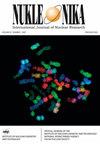HEMA基水凝胶中金纳米粒子的放射分解合成:纳米复合材料成像潜力
IF 0.3
4区 物理与天体物理
Q4 CHEMISTRY, INORGANIC & NUCLEAR
引用次数: 0
摘要
摘要本文报道了在两种基于甲基丙烯酸2-羟基乙酯(HEMA)的水凝胶中放射性合成含金纳米颗粒(AuNPs)的纳米复合材料:(i)在乙二醇二甲基丙烯酸酯(EGDMA)中具有不同含量的平面网络,和(ii)由这些单体与[2-(甲基丙烯酰氧基)乙基]三甲基氯化铵(MADQUAT)共聚制备的刺激响应性(SR)网络,以赋予pH可切换的溶胀。水凝胶是通过光聚合制备的,具有明确的组成和高单体转化率,使用两种实验程序,如干凝胶或水溶液。除MADQUAT外,丙烯酸(AA)或N-异丙基丙烯酰胺已被测试为共聚物,分别产生pH或温度敏感的水凝胶。在水中的等温溶胀受单体组成的影响。剂量高达100kGy的聚(HEMA)干凝胶和用0.5wt%的EGDMA制备的水溶胀网络的电子束(EB)照射对普通材料的溶胀特性和热机械性能具有中等影响,而形成了少量的可提取物。通过对Au(III)水溶液溶胀的样品进行EB辐照,成功地获得了含有AuNPs的聚(HEMA)基纳米复合材料。通过紫外-可见光谱法监测了剂量和交联密度对AuNPs形成的影响。负载Au(III)的SR水凝胶在明确温度下的辐照诱导了具有尺寸依赖性特征的纳米颗粒的形成,而在10kGy下Au(Ⅲ)还原的效率不受网络结构的显著影响。EB诱导的聚(HEMA)水凝胶中Au(III)的还原使用铅掩模产生明确的图案,在形成纳米复合材料的区域产生彩色和持久的图像。本文章由计算机程序翻译,如有差异,请以英文原文为准。
Radiolytic synthesis of gold nanoparticles in HEMA-based hydrogels: Potentialities for imaging nanocomposites
Abstract This article reports on the radiolytic synthesis of nanocomposites containing gold nanoparticles (AuNPs) within two types of hydrogels based on 2-hydroxyethyl methacrylate (HEMA): (i) plain networks with various contents in ethylene glycol dimethacrylate (EGDMA), as a cross-linker and (ii) stimuli-responsive (SR) networks prepared from these monomers copolymerized with [2-(methacryloyloxy)ethyl]trimethylammonium chloride (MADQUAT) to confer pH-switchable swelling. Hydrogels were prepared by photopolymerization with well-defined composition and a high degree of monomer conversion using two experimental procedures, as xerogels or in aqueous solution. Besides MADQUAT, acrylic acid (AA) or N-isopropylacrylamide have been tested as copolymers, yielding pHor temperature-sensitive hydrogels, respectively. Isothermal swelling in water was affected by monomer composition. Electron beam (EB) irradiation at doses up to 100 kGy of poly(HEMA) xerogels and water-swollen networks prepared with 0.5 wt% of EGDMA had a moderate impact on swelling characteristics and thermomechanical properties of the plain materials, whereas small amounts of extractables were formed. Poly(HEMA)-based nanocomposites containing AuNPs were successfully obtained by EB irradiation of samples swollen by aqueous solutions of Au(III). The effects of dose and cross-linking density on the formation of AuNPs were monitored by UV-visible spectroscopy. Irradiation at well-defined temperatures of the Au(III)-loaded SR hydrogels induced the formation of nanoparticles with size-dependent features, whereas the efficiency of Au(III) reduction at 10 kGy was not significantly affected by the network structure. EB-induced reduction of Au(III) in poly(HEMA) hydrogels using a lead mask to generate well-defined patterns yielded coloured and long-lasting images in the zones where the nanocomposite was formed.
求助全文
通过发布文献求助,成功后即可免费获取论文全文。
去求助
来源期刊

Nukleonika
物理-无机化学与核化学
CiteScore
2.00
自引率
0.00%
发文量
5
审稿时长
4-8 weeks
期刊介绍:
"Nukleonika" is an international peer-reviewed, scientific journal publishing original top quality papers on fundamental, experimental, applied and theoretical aspects of nuclear sciences.
The fields of research include:
radiochemistry, radiation measurements, application of radionuclides in various branches of science and technology, chemistry of f-block elements, radiation chemistry, radiation physics, activation analysis, nuclear medicine, radiobiology, radiation safety, nuclear industrial electronics, environmental protection, radioactive wastes, nuclear technologies in material and process engineering, radioisotope diagnostic methods of engineering objects, nuclear physics, nuclear reactors and nuclear power, reactor physics, nuclear safety, fuel cycle, reactor calculations, nuclear chemical engineering, nuclear fusion, plasma physics etc.
 求助内容:
求助内容: 应助结果提醒方式:
应助结果提醒方式:


